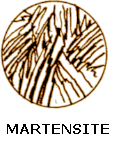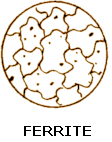



|
|---|
 |
 |
 |
 |
 |
 |
 |
 |
 |
|---|
 |
 |
 |
 |
 |
| Heat Treatment | |||||
| INTRODUCTION | |||||
Machining induces stresses in parts. The bigger and more complex the part, the more the stresses. These stresses can cause distortions in the part long term. If the parts are clamped in service, then cracking could occur. Also hole locations can change causing them to go out of tolerance. For these reasons, stress relieving is often necessary. Typically, the parts that benefit from stress relieving are large and complex weldments, castings with a lot of machining, parts with tight dimensional tolerances and machined parts that have had a lot of stock removal performed. |
|||||
| HEAT TREATMENT PROCESS | |||||
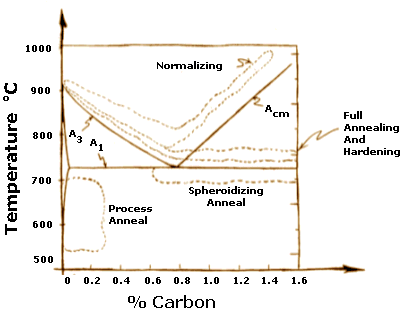 |
|||||
| >>Top of Page<< | |||||
| STRESS RELIEVING | |||||
| Stress relieving is done by subjecting the parts to a temperature of about 75 ºC (165 ºF) below the transformation temperature,line A1 on the diagram, which is about 727 ºC (1340 ºF) of steel—thus stress relieving is done at about 650 ºC (1202 ºF) for about one hour or till the whole part reaches the temperature. This removes more than 90% of the internal stresses. Alloy steels are stress relieved at higher temperatures. After removing from the furnace, the parts are air cooled in still air. | |||||
Full annealing is the process of slowly raising the temperature about 50 ºC (90 ºF) above the Austenitic temperature line A3 or line ACM in the case of Hypoeutectoid steels (steels with < 0.77% Carbon) and 50 ºC (90 ºF) into the Austenite-Cementite region in the case of Hypereutectoid steels (steels with > 0.77% Carbon). |
|||||
It is held at this temperature for sufficient time for all the material to transform into Austenite or Austenite-Cementite as the case may be. It is then slowly cooled at the rate of about 20 ºC/hr (36 ºF/hr) in a furnace to about 50 ºC (90 ºF) into the Ferrite-Cementite range. At this point, it can be cooled in room temperature air with natural convection. |
|||||
|
|||||
The grain structure has coarse Pearlite with ferrite or Cementite (depending on whether hypo or hyper eutectoid). The steel becomes soft and ductile. |
|||||
| >>Top of Page<< | |||||
| NORMALIZING | |||||
Normalizing is the process of raising the temperature to over 60 º C (108 ºF), above line A3 or line ACM fully into the Austenite range. It is held at this temperature to fully convert the structure into Austenite, and then removed form the furnace and cooled at room temperature under natural convection. This results in a grain structure of fine Pearlite with excess of Ferrite or Cementite. The resulting material is soft; the degree of softness depends on the actual ambient conditions of cooling. This process is considerably cheaper than full annealing since there is not the added cost of controlled furnace cooling. The main difference between full annealing and normalizing is that fully annealed parts are uniform in softness (and machinablilty) throughout the entire part; since the entire part is exposed to the controlled furnace cooling. In the case of the normalized part, depending on the part geometry, the cooling is non-uniform resulting in non-uniform material properties across the part. This may not be desirable if further machining is desired, since it makes the machining job somewhat unpredictable. In such a case it is better to do full annealing. |
|||||
| >>Top of Page<< | |||||
| PROCESS ANNEALING | |||||
| Process Annealing is used to treat work-hardened parts made out of low-Carbon steels (< 0.25% Carbon). This allows the parts to be soft enough to undergo further cold working without fracturing. Process annealing is done by raising the temperature to just below the Ferrite-Austenite region, line A1on the diagram. This temperature is about 727 ºC (1341 ºF) so heating it to about 700 ºC (1292 ºF) should suffice. This is held long enough to allow recrystallization of the ferrite phase, and then cooled in still air. Since the material stays in the same phase through out the process, the only change that occurs is the size, shape and distribution of the grain structure. This process is cheaper than either full annealing or normalizing since the material is not heated to a very high temperature or cooled in a furnace. | |||||
| >>Top of Page<< | |||||
| STRESS RELIEF ANNEALING | |||||
| Stress Relief Anneal is used to reduce residual stresses in large castings, welded parts and cold-formed parts. Such parts tend to have stresses due to thermal cycling or work hardening. Parts are heated to temperatures of up to 600 - 650 ºC (1112 - 1202 ºF), and held for an extended time (about 1 hour or more) and then slowly cooled in still air. | |||||
| >>Top of Page<< | |||||
| SPHEROIDIZATION | |||||
Spheroidization is an annealing process used for high carbon steels (Carbon > 0.6%) that will be machined or cold formed subsequently. This is done by one of the following ways: |
|||||
|
|||||
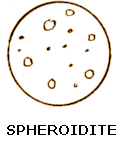 |
|||||
| All these methods result in a structure in which all the Cementite is in the form of small globules (spheroids) dispersed throughout the ferrite matrix. This structure allows for improved machining in continuous cutting operations such as lathes and screw machines. Spheroidization also improves resistance to abrasion. | |||||
| >>Top of Page<< | |||||
Tempering is a process done subsequent to quench hardening. Quench-hardened parts are often too brittle. This brittleness is caused by a predominance of Martensite. This brittleness is removed by tempering. Tempering results in a desired combination of hardness, ductility, toughness, strength, and structural stability. Tempering is not to be confused with tempers on rolled stock-these tempers are an indication of the degree of cold work performed. |
|||||
|
|||||
The mechanism of tempering depends on the steel and the tempering temperature. The prevalent Martensite is a somewhat unstable structure. When heated, the Carbon atoms diffuse from Martensite to form a carbide precipitate and the concurrent formation of Ferrite and Cementite, which is the stable form. Tool steels for example, lose about 2 to 4 points of hardness on the Rockwell C scale. Even though a little strength is sacrificed, toughness (as measured by impact strength) is increased substantially. Springs and such parts need to be much tougher — these are tempered to a much lower hardness. Tempering is done immediately after quench hardening. When the steel cools to about 40 ºC (104 ºF) after quenching, it is ready to be tempered. The part is reheated to a temperature of 150 to 400 ºC (302 to 752 ºF). In this region a softer and tougher structure Troostite is formed. Alternatively, the steel can be heated to a temperature of 400 to 700 ºC (752 to 1292 ºF) that results in a softer structure known as Sorbite. This has less strength than Troostite but more ductility and toughness. The heating for tempering is best done by immersing the parts in oil, for tempering upto 350 ºC (662 ºF) and then heating the oil with the parts to the appropriate temperature. Heating in a bath also ensures that the entire part has the same temperature and will undergo the same tempering. For temperatures above 350 ºC (662 ºF) it is best to use a bath of nitrate salts. The salt baths can be heated upto 625 ºC (1157 ºF). Regardless of the bath, gradual heating is important to avoid cracking the steel. After reaching the desired temperature, the parts are held at that temperature for about 2 hours, then removed from the bath and cooled in still air. |
|||||
| >>Top of Page<< | |||||
| AUSTEMPERING | |||||
|
|||||
| >>Top of Page<< | |||||
| T-T-T DIAGRAM EUTECTOID STEEL | |||||
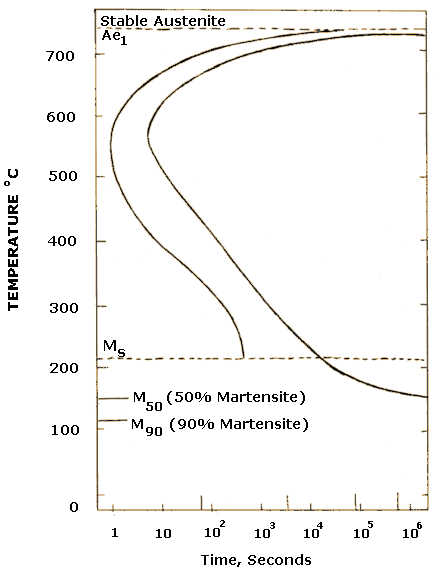 |
|||||
| >>Top of Page<< | |||||
| MARTEMPERING | |||||
| Martempering is similar to Austempering except that the part is slowly cooled through the martensite transformation. The structure is martensite, which needs to tempered just as much as martensite that is formed through rapid quenching. The biggest advantage of Austempering over rapid quenching is that there is less distortion and tendency to crack. | |||||
| >>Top of Page<< | |||||


